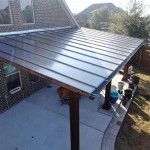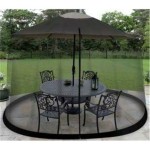How To Create An Inviting Patio Pavilion In Your Backyard
A patio pavilion adds a touch of elegance and functionality to any backyard. It provides a sheltered space for relaxation and entertainment, extending the usability of outdoor areas regardless of the weather. Creating an inviting patio pavilion involves careful planning and execution, encompassing design, material selection, and thoughtful decoration.
Planning and Design
The initial stage involves determining the pavilion's purpose. Will it primarily serve as a dining area, a lounge space, or a general-purpose outdoor room? This dictates the size and layout of the structure. Accurate measurements of the designated area are crucial for ensuring the pavilion fits comfortably within the available space while allowing for free movement around it.
Consider the existing landscape and architectural style of the home. The pavilion's design should complement, not clash with, the surrounding environment. Options range from classic gable roofs to more contemporary curved or hip roof designs. Integrating the pavilion seamlessly with existing patios, decks, or gardens enhances the overall aesthetic.
Material Selection
Choosing durable and weather-resistant materials is paramount for longevity and minimal maintenance. Popular choices for pavilion structures include wood, metal, and vinyl. Wood offers a natural, warm aesthetic but requires regular staining and sealing to prevent rot and insect damage. Cedar and redwood are naturally resistant to decay and are preferred choices. Metal, such as aluminum or steel, provides strength and durability with less maintenance but can be susceptible to rust if not properly treated. Vinyl offers a low-maintenance option but may not be as aesthetically pleasing as wood or metal.
Roofing materials also play a significant role in the pavilion's durability and aesthetic. Options include asphalt shingles, metal roofing, polycarbonate panels, and natural materials like thatch or cedar shakes. Each material offers varying degrees of weather protection, longevity, and aesthetic appeal. Consider the local climate when selecting roofing materials to ensure adequate protection from rain, snow, and sun.
Construction and Installation
Constructing a patio pavilion can be a complex undertaking, often requiring professional assistance. Obtaining necessary permits from local authorities is essential before commencing construction. A professional contractor can ensure the structure adheres to building codes and safety regulations.
The foundation is critical for stability. Concrete footings or piers are typically used to anchor the pavilion and prevent shifting or settling. The frame is then constructed using the chosen material and secured to the foundation. Roofing is installed, followed by any necessary electrical wiring for lighting or other amenities.
Creating an Inviting Atmosphere
Once the structure is complete, the focus shifts to creating an inviting atmosphere. Comfortable seating is essential, whether it's a dining set, lounge chairs, or a combination of both. Cushions, throws, and outdoor rugs add comfort and visual appeal. Incorporating a fire pit or outdoor fireplace provides warmth and ambiance, extending the usability of the pavilion into cooler evenings.
Lighting plays a crucial role in setting the mood. String lights, lanterns, and spotlights can create a warm and inviting atmosphere. Consider installing dimmer switches to adjust the lighting to suit different occasions. Adding outdoor curtains or screens provides privacy and protection from insects while enhancing the pavilion's aesthetic appeal.
Landscaping and Decor
Integrating the pavilion with the surrounding landscape enhances its visual appeal. Planting flowers, shrubs, and trees around the pavilion creates a natural and inviting setting. Consider using climbing plants to create a living wall or roof, adding a touch of greenery and shade. Potted plants can also be used to add color and texture.
Decorative elements personalize the space and reflect individual style. Outdoor artwork, sculptures, and water features can add visual interest. Consider adding a sound system for entertainment or a ceiling fan for air circulation. The goal is to create a space that is both functional and aesthetically pleasing, providing a comfortable and inviting retreat for relaxation and entertainment.
Maintenance and Care
Regular maintenance is crucial for preserving the pavilion's beauty and extending its lifespan. This includes cleaning the structure regularly, removing debris, and checking for any signs of damage. Wood structures require periodic staining and sealing to protect against the elements. Metal structures should be inspected for rust and treated accordingly. Fabric elements, such as cushions and curtains, should be cleaned and stored properly during the off-season.
By following these guidelines, one can create a beautiful and functional patio pavilion that enhances the backyard experience and provides a welcoming outdoor space for years to come. Careful planning, material selection, and thoughtful decoration are key to creating a space that is both aesthetically pleasing and practical.

How To Create The Backyard Space Of Your Dreams Patiova Resources

How To Create Inviting Outdoor Living Spaces Dot Com Women Backyard Fireplace Patio

Guest Blog 5 Tips To Make Your Outdoor Space More Inviting Hardscape Landscape Supplier Hardscaping Materials Pa Nj
Homework Pergolas Gazebos And Pavilions Make A Yard Inviting Newsday

The Many Uses Of Pavilions For Backyards From Entertaining To Storage Legacy Decks

Outdoor Kitchen Pavilions A Complete Guide 2024

5 Ways To Use A Backyard Pavilion Country Lane Gazebos

5 Inspiring Backyard Pavilion Ideas Models Find Your Best Pavilions

Backyard Makeover On A Budget 7 Best Inexpensive Ideas

Inspiring Design Ideas For A Backyard Porch Or Patio Cozy Outdoor Decor Pergola
Related Posts








